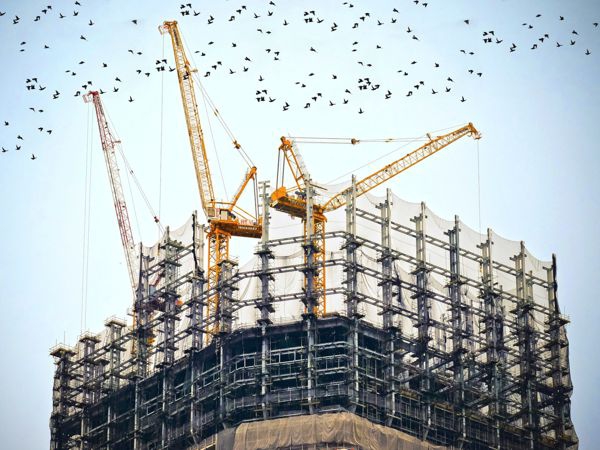Crane Safety Toolbox Talk - Safety Checklist & Resources
Cranes are among the most powerful and essential machines on construction sites. Their ability to lift and move massive loads makes them indispensable, but it also brings significant risks if not handled properly. These large, complex machines require strict adherence to safety protocols to protect workers, bystanders, and nearby structures.
According to the Bureau of Labor Statistics (BLS) and OSHA, approximately 40 construction workers lose their lives each year due to crane-related accidents. As a result, cranes weighing more than 2,000 pounds are subject to strict regulations. Operators must be certified by the National Commission for the Certification of Crane Operators (NCCCO). Companies that operate cranes are legally responsible for any damage or harm caused, which is why many invest in specialized insurance coverage.
Safety signs and stickers are crucial for communicating risks on a job site. OSHA and ANSI provide guidelines for visual warnings used on cranes. Common materials include vinyl, polyester, aluminum, and plastic. Many suppliers, like SafetySign.com and Amazon, offer a variety of options. In areas with multiple languages, bilingual signs can improve clarity and safety.
Before and after each lift, use an air horn or audible alarm to alert nearby workers. Different signals can be used to indicate “start,†“all clear,†and “finish.†These alerts help ensure that even those not directly watching the crane are aware of ongoing operations.
Proper lighting is essential for visibility, especially in low-light conditions or bad weather. Warning lights and spotlights around the crane help identify its location and reduce the risk of accidents. Lighting ensures that the crane stands out against its surroundings, making it easier for workers to stay safe.
Transporting cranes requires careful planning, especially in urban or industrial environments. Before moving, study the route, measure dimensions, and account for extra space around turns. Spotters are often needed to guide the crane through tight spaces. Always follow local laws regarding oversized loads, including warning flags, signs, and possible police escorts.
Be mindful of weight limits on bridges and roads. Some cranes may exceed these limits, so checking the route in advance is essential to avoid delays or damage.
A lift plan is similar to an architectural blueprint—it outlines every detail to ensure a safe and successful operation. It includes the load's weight, the crane's lifting capacity, center of gravity, dimensions, and lifting points. It also covers rigging requirements, height restrictions, and risk mitigation strategies.
Once created, the lift plan must be shared with all involved parties. Since plans can change, it’s important to update and distribute the latest version to everyone to avoid confusion.
Clear communication between the crane operator and signal person is vital. OSHA has established standardized hand signals to ensure consistency across the industry. Below are some of the most commonly used signals.
Source: Full OSHA Crane Guidelines
When renting a crane, many companies offer valuable resources, including certified operators, transportation services, and assistance with lift planning. It's always wise to consult with your rental provider early in the process to ensure you have everything you need for a safe and efficient operation.
12 types of cranes
#cranes
#material handling
#checklists
#construction
#toolbox talks
Application
Powder Coating Precipitated Barium Sulfate is equal to Blanc Fix which with a defined particle size from highly purified solutions of barium salts to sodium sulfate.
TDS
Appearance:White;
Barium Sulfate(%):apx.98.6
Oil Absorption(g oil/100g):approx.14
Mean gain size D50(UM):<1.0
Our Advantage & Service:
Precipitated Barium Sulfate,Powder Coating Baso4,Blanc Fix,Painting Ink Baso4,Plastic Precipitated Barium Sulfate Yantai Yuanli Corp Ltd , https://www.yuanlicorpcn.com
Cranes Are Often The Most Powerful Equipment On The Job
Crane Safety Toolbox Talk
Checklist of critical items to monitor before moving a load
Checklist of critical items to monitor while moving a load
Toolbox Talk Outline
Safety Equipment - Signs, Air Horns & Lights
Safety Signs and Stickers
Air Horns and Audible Signals
Safety Lights
Transportation of Cranes
Lift Plan
OSHA Crane Safety Hand Signals
Arm extended horizontally to the side, palm down, arm swung back and forth.
Both arms extended horizontally to the side, palms down, arms swung back and forth.
Upper arm extended to the side, forearm and index finger pointing straight up, hand and finger make small circles.
Arm extended horizontally to the side, thumb up, other fingers closed.
Arm extended horizontally, index finger points in direction of swing.
Hands at waist level, thumbs pointing at each other, other fingers closed.
Arm extended horizontally to the side, thumb up, fingers open and close while load movement is desired.
Hands held together at waist level.
Arm and index finger pointing down, hand and finger make small circles.
Arm extended horizontally to the side, thumb down, other fingers closed.
Hands at waist level, thumbs pointing outward, other fingers closed.
Fingers up, arm extended horizontally out and back to push in the direction of travel.
Arm extended horizontally to the side, thumb down, fingers open and close while load movement is desired.
One hand placed in front of the action signal hand.
Arm bent at elbow, forearm vertical, tapped with other hand. Then regular signal is used to indicate action.
Rotate fists around each other in front of body; rotation away from body indicates forward; toward body indicates backward.
Tap top of head with one hand, then give regular signal to indicate action.
Raise fist on the side of the track to be locked. Rotate other fist in direction of travel.
Palm up, fingers closed, thumb pointing in direction of motion, hand jerked horizontally in that direction.
Crane Rental
Resources
OSHA Crane, Derrick and Hoist Safety
Crane safety video
Find Similar Articles By Topic